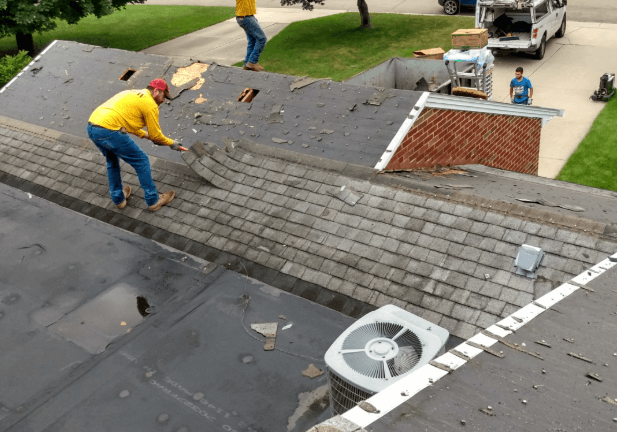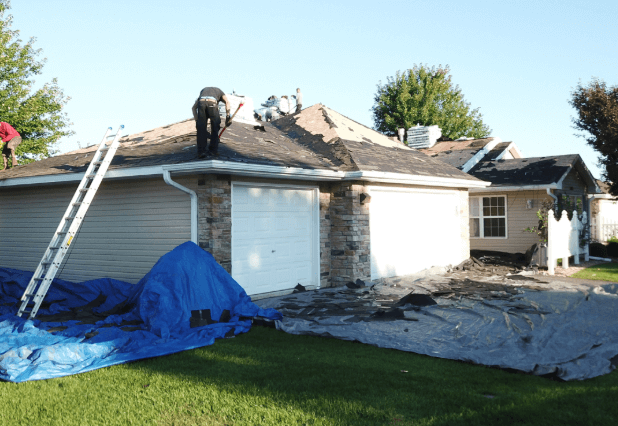Storms can wreak havoc on your home, especially your roof. High winds, hail, and heavy rain can cause significant damage.
When the storm subsides, you’re left with the daunting task of roof repair. It’s crucial to act promptly to prevent further damage.
This guide provides top tips for roof repair after storms. It’s designed to help homeowners navigate the process effectively.
You’ll learn how to assess damage safely and understand the importance of immediate protective measures. We’ll also guide you through choosing the right roofing contractor.
Understanding the difference between roof repair and replacement is vital. We’ll delve into this, along with navigating insurance claims and avoiding common roofing scams.
Lastly, we’ll discuss long-term roof maintenance and prevention. Our goal is to help you ensure quality and affordability in your roof repair journey.
Assessing the Damage Safely
The first step in repair after a storm is to assess the damage. However, safety should always come first. Stay on the ground while inspecting your roof using binoculars or a camera zoom.
Look for visible signs of damage that can impact its integrity.
- Check for missing or damaged shingles.
- Look for dented metal vents or gutters.
- Notice any loose or broken flashing.
These signs may indicate hail and wind damage. Identifying these issues promptly can prevent further complications. If in doubt, always call a professional for a thorough inspection.
Immediate Steps to Protect Your Roof
After assessing the damage, take immediate action. Quick measures can prevent further damage to your property. Start by using tarping for temporary protection against leaks.
Debris removal is another essential step in mitigating damage. High winds often scatter branches and other debris across rooftops.
- Clear gutters and downspouts.
- Remove branches or loose objects.
- Ensure water can drain freely.
Taking these actions can help safeguard your home until a professional contractor can assess and repair the damage properly. Prompt attention is vital in storm damage restoration to minimize both immediate and long-term issues.
Choosing the Right Contractor

Selecting the right contractor is vital for ensuring quality repairs. A professional with experience can accurately assess and address hail and wind damage. Begin your search by looking for ‘storm damage roof repair near me’ through online directories and local referrals.
When selecting a roofing company, prioritize those with licenses and insurance. This ensures their credibility and your protection. Licensed contractors are familiar with local building codes and standards, which is crucial for compliance.
Consider these tips when choosing a contractor:
- Check online reviews and testimonials.
- Ask for references from previous clients.
- Verify licenses and insurance coverage.
These measures help ensure you hire a reputable contractor capable of delivering quality work. A knowledgeable professional will repair your roof effectively and provide peace of mind. Make informed decisions by doing some research before committing to a contractor.
Understanding Repair vs. Replacement
Deciding between roof repair and replacement depends on the extent of the damage. Minor issues such as a few missing shingles might only require a simple repair. However, extensive hail and wind damage may necessitate a full roof replacement to ensure structural integrity.
Opting for a complete roof replacement can significantly impact your property’s value. A new roof not only enhances curb appeal but also provides long-term protection. Additionally, investing in replacement might affect your insurance policy, potentially leading to premium adjustments or improved coverage terms. Always weigh your options carefully and consult a roofing professional to determine the best action.
Navigating Insurance Claims for Roof Repair
Dealing with insurance claims after storm damage can feel overwhelming. The key to a successful claim is thorough documentation. Take detailed photos of the damage, capturing different angles. Include any receipts for temporary repairs, like tarping, which can be reimbursed by your insurer.
Once documentation is complete, reach out to your insurance company promptly. Initiate the claim by providing all necessary information about the damage. Be prepared to answer questions and offer detailed accounts of the storm’s impact on your roof.
Throughout the claim process, clear communication is essential. Keep a written record of all interactions with your insurer. Here are essential steps to aid in navigating insurance claims:
- Document every detail of damage with photos and written descriptions.
- Contact your insurance company immediately with the gathered documentation.
- Maintain a log of communications and updates throughout the claim process.
Adequate preparation and persistence can ensure a smoother insurance claim experience.
Avoiding Common Roofing Scams
In the aftermath of a storm, roofing scams can be alarmingly common. Be wary of contractors who show up uninvited, offering services at suspiciously low prices. Such individuals often push you to sign contracts hastily or demand large upfront payments. These can be red flags.
Always verify the credentials of your potential roofing contractor. Check for local licenses and insurance. Legitimate contractors are usually members of professional associations. Don’t hesitate to ask for references from past clients. A reliable contractor will have a solid track record and positive reviews.
It’s vital to do your due diligence before hiring a roofing company. Take your time to research thoroughly to avoid being exploited. Investing a little time upfront can save you from costly mistakes and unsatisfactory repair work.
Long-Term Roof Maintenance and Prevention

Protecting your roof from future storms begins with regular maintenance. Routine inspections help identify minor issues before they become major problems. Fixing small damages early can prevent costly repairs later on.
Here are some effective maintenance tips and preventative measures to minimize storm damage:
- Clean gutters and downspouts to ensure proper water drainage.
- Trim tree branches that could fall during storms.
- Check for loose shingles and damaged flashing.
- Ensure attic ventilation to prevent moisture build-up.
- Schedule professional roof inspections annually.
By adopting these practices, you can extend your roof’s lifespan. Additionally, proactive maintenance safeguards your home, ensuring it’s better prepared to withstand future weather challenges. Staying vigilant with these tasks can preserve the value and integrity of your property.
Ensuring Quality and Affordability
Finding a balance between cost and quality is crucial when dealing with roof repair. Homeowners often face the dilemma of choosing between affordable options and high-quality outcomes. However, cutting corners can lead to more expenses later on.
To protect your investment, seek roof repair services that offer solid warranties and guarantees. These assurances not only provide peace of mind but ensure that the job meets high standards. A warranty demonstrates the contractor’s confidence in their work and materials, offering you extra protection.
Remember that quality should never be compromised in your quest for affordable solutions. Investing in reliable services means safeguarding your home and its longevity. This approach ensures the best value, maintaining the integrity of your property for years.
Don’t wait for small roof issues to become major problems. Act now and contact Timberline Roofing and Contracting. Taking timely action can preserve your property and prevent costly repairs in the future. Reach out to our roofing professionals who can evaluate and restore your roof with expertise and care.

